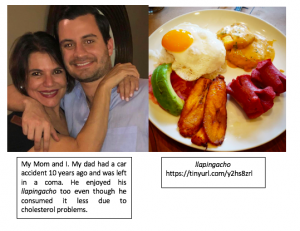***
I submitted it via email in time because I couldn’t figure out how to do it through here. Thanks to Professor Hong help, now I am uploading it here. I am uploading the word document, in which you can see it way better.
Word Document: Journal #1
***
Simón Crespo Pérez
July 7th, 2019
Journal #1: Llapingacho
Paragraph #1: Why do you like this dish and what is the significance of it for you?
Llapingacho, which consists of fried cheese potato pancakes served with rice, sausage, avocado (or salad), fried eggs, fried plantains, and a special peanut sauce, is a dish that is important to me since it represents my cultural and family background. It represents my cultural background because it is originally from Ecuador’s Andes Region, my home country, and it represents my family background because it has been a favorite of my family all the way from previous generations to mine. I remember since I was a little child that we will meet with my whole extended family in the house of my grandmother every Sunday. We would proceed to engage in highly entertaining conversations until around 2:30PM when lunch was served. The menu variated each Sunday between yapingachoand ceviche, which is another delicious dish from my small part of the world. The way the dish is made in my grandmother’s house was so good, we never got tired of it. Sadly, she passed away, but I will try to find her original recipe and frame it because every time I eat a yapingachoI am reminded of her. It would be amazing to hang her hand-written recipe in my room. Clearly, llapingachobrings taste to my mouth, and nostalgia to my heart.
Paragraph #2: Include a photo of the dish and a photo of yourself or family. Please provide the source of the photos if you don’t own the copyright.

Paragraph #3: Research the history, culture, or geographic information relevant to the dish.
For this part of the assignment, I contacted a family friend and also llapingacholover, well-known Ecuadorian historian, José A. Gómez-Iturralde. According to him, the plate is original from Ambato, Ecuador, which is a city in Ecuador’s Andes Region, one of the four regions of Ecuador together with Galapagos Islands, Ecuador’s Coastal Region, and Ecuador’s Amazon Region. It originated in Ambato, or as he calls it the Garden of Ecuador due to its variety of species. All elements of the llapingachocan be found in this region. According to him, it has so many species that there is a Festival of Fruits and Flowers every year to commemorate the anniversary of the earthquake that destroyed the city in the late 1940’s and killed around 6000 citizens. It originated there thanks to the Native Ecuadorians of the region, who made the fried cheese potato pancakes component of the dish even before Columbus arrived to America. The name of the dish comes from the Native Ecuadorian word llapin, which means mashed, just like the fried cheese potato pancakes.
Recipe (Not Included in Page Count): I don’t cook, but I found the best recipe in the following website, https://www.myrecipes.com/recipe/llapingachos-ecuatorianos-ecuadorean-potato-and-cheese-patties.

Hi, Simón, this is the first time I ever heard about llapingacho, and your post has been most informative! Llapingacho has certainly been one of the most complicated dishes I’ve ever known of–consisting of fried cheese potato pancakes, rice, sausage, avocado, fried eggs, fried plantains, and peanut sauce. It must be very delicious. You are very lucky! The family tradition you described in paragraph#1–that your extended family would have a weekly gathering and lively conversations–sounds amazing. By the way, it’s the second time I heard about ceviche in the class. Francesca Cabada chose it as her favorite dish–feel free to search for her post on our course website and have a read! I’m sure you’d be quite interested. I’m thrilled that you reached out to a well-known Ecuadorian historian for this assignment! Thank you for making such an effort. The only thing I hoped you’d work on more is reflecting upon the cultural and social elements of llapingacho. I’m interested in knowing how you understand yourself in relation to the dish, and in what ways do you find it constitutive of your self-identity. You mentioned the feelings of nostalgia–I wonder what else is there, besides memories of your grandmother. I’d encourage you to delve deeper. You’ll be amazed at what you discover.